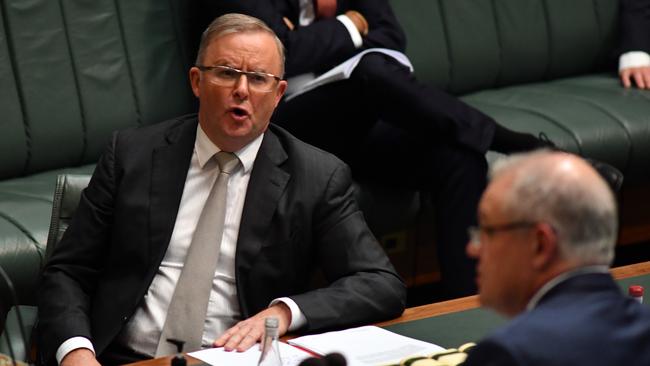Albanese goes all in with high-stakes gamble over JobKeeper
Anthony Albanese’s JobKeeper play will decide the next election.

Just as the Opposition Leader called for the government to go “hard and early” with locking down the nation to deal with the coronavirus outbreak, the decision to launch a full political attack on the Prime Minister’s handling of the crisis is both bold and risky.
Labor is declaring the Morrison government’s attempts to save jobs and revive the economy are a failure and is staking out a political alternative based on an even bigger taxpayer-supported job scheme, an extension of the schemes beyond September, higher welfare payments, support for higher wages, opposition to more labour market flexibility, restricting immigration, bringing forward infrastructure projects and creating a national social housing stimulus scheme.
On the weekend of the first anniversary of Labor’s rejection at the May 18 election and the 11th anniversary of the Rudd government’s economic recovery response to the global financial crisis, Albanese is proffering an alternative Labor “vision” to restore and permanently change Australia’s economy and priorities drawing on the experience of avoiding recession in 2009.
There are serious dangers of miscalculation for Labor if the GFC is taken as a template because the different circumstances, aims, scale and nature of the two crises mean many of the 2009 solutions aren’t appropriate now, and are even counter-productive.
On the anniversary of his “miracle” election victory, the Prime Minister wants to address the “here and now” on health and economic management, with the hope of recovering as soon as possible and with as few job losses as possible.
“To get Australians back into work, that is the curve we are working on now,” he said at his national cabinet briefing in Canberra on Friday.
All sides agree the economic impact of the coronavirus is devastating, both personally and to the nation. All sides agree that Australia faces a catastrophic pandemic requiring unprecedented health and economic measures to limit the once-in-a-century impact. All sides now agree that, in global terms, Australia’s health response has been among the best.
And all sides also agree that the pace and size of the economic recovery — particularly measured by the numbers of unemployed and the creation of new jobs — is going to be the real benchmark and political battle line during the next two years.
The Coalition’s $130bn JobKeeper program is the focus of the political and economic argument and it will be the litmus test that decides the fate of Morrison and Albanese — such is the size of the political risk and the ferocity of Labor’s attack.
Barely three months into the virus crisis, the hard political differences have crystallised. Last month’s full percentage point rise to 6.2 per cent unemployment, putting 1.6 million on to the revamped JobSeeker dole, has shattered any pretence after months of declared bipartisanship.
In unshackling any restraint over COVID-19, Labor has declared Morrison’s JobKeeper program — which supplies or supplements the wages of six million workers through more than 850,000 businesses — a failure, a bungled program and a deliberate act to put 600,000 people on the dole. Albanese said the Coalition “is a government that we’ve seen didn’t have a plan for the economy before the bushfire crisis hit and before the coronavirus crisis hit”.
He said the Morrison government was interested only in “day-to-day political management” and Liberal Party marketing.
“They have no plan to come out of this crisis at all. No infrastructure investment foreshadowed. No plan, just snap back. Snap back to what was there,” Albanese said. He also said “snap back” meant cutbacks and a sudden end to job support. In parliament Albanese accused Morrison of failing on the bushfire crisis and on the coronavirus economic recovery.
Morrison’s response to the political attack was that Albanese was “white-anting” the government’s efforts to engineer an economic recovery and politicising the pandemic for his own ends. Morrison also argued that he was concentrating on the “here and now” and it was premature in both health and economic terms to talk about success when there could be a second wave of COVID-19 outbreaks.
Morrison did not downplay last month’s jobless figures. Indeed, he said there was a deeper impact than just the headline 6.2 per cent, and there was worse to come. But he defended the $1500-a-fortnight JobKeeper allowance, paid through businesses to keep workers “in touch” with their jobs.
“The JobKeeper program has been incredibly effective. I mean, six million Australians have been supported at their worst moment, and hundreds of thousands of businesses,” he said.
Accelerating the timing and scale of workers leaving JobKeeper and returning to their jobs, as well as the ability to create new jobs for the 1.6 million unemployed, is Morrison’s aim — although it is clear that suggestions of a sharp V-shaped recovery are unlikely to be realised; recovery now is expected to look more like a lazy U-shaped curve.
This is where Albanese is concentrating his political critique of the Coalition and seeking to offer a different “vision” and “practical solutions” as he campaigns in the Eden-Monaro by-election in southern NSW, his first electoral test as Labor leader.
Albanese’s key prescriptions are an expansion and extension of the JobKeeper program, infrastructure spending and dedicated social housing construction aimed at stopping the building industry from “falling off a cliff”.
For Morrison, the judgment on his policies, which so far have received overwhelming public support and boosted consumer and business confidence, will be easier because there will be concrete outcomes to assess.
For Albanese, the test is more difficult, but an examination of the ALP’s last election policies and response to the 2009 GFC can assess Labor’s current prescriptions. There is no doubt the Rudd government’s economic stimulus helped fend off a recession in 2009-10, but equally there is no doubt that there were failures where the federal government took on roles in which it wasn’t capable and extended debt-inducing stimulus long after it was necessary.
This week, Albanese championed stimulus for the building industry because contracts for new housing had plummeted. Yet a year ago Labor was seeking government based on changes to property investment rules that all the housing and building industries opposed and believed would drive them “off a cliff”.
In 2009, the social and defence housing stimulus was slow to be implemented — as opposed to the so-called “shovel ready” school building and local government program — with $10bn of the $14bn not being distributed until 2010 and 2011.
The housing circumstances were also different in 2009. A period of relatively high interest rates meant there was pent-up demand, particularly from first-home buyers, and there was much room for monetary policy changes, with the Reserve Bank cutting official rates by three percentage points between October 2008 and April 2009. Even as the government was pushing out housing stimulus, the RBA was pushing up rates again — six months in a row, between October 2009 and May 2010 — to control inflation and dampen demand.
The RBA’s assessment of the key reasons for Australia’s success in dealing with the GFC was the strength of the banking system, limited exposure to subprime loans and that eight of our top 10 trading partners were in Asia, including China.
Last year, Lindsay Tanner, Rudd’s finance minister and one of the “gang of four” that directed the GFC response, expressed regret at the handling of some stimulus projects, including the notorious and rorted $2.8bn home insulation scheme, and credited a large part of the survival on Australia’s zero national debt in 2008.
Tanner also agreed with the argument that it was China’s mineral imports that were crucial in heading off a negative March quarter of growth and recession. But he noted another two “important factors” not connected to stimulus spending — compulsory superannuation, which provided a constant flow of new investment, and immigration, which drove consumer demand.
Today, Australia faces the prospect of a trade war with China and a Labor campaign to take advantage of the zero immigration during the crisis to limit migration and put “Australian jobs first”.
Ironically, one of the factors helping the Rudd government was the highly flexible labour market laws of the Howard government that allowed employers to adjust quickly. This week, Labor joined with the Greens to try to block temporary changes to the award systems that employers desperately need to keep their businesses afloat.
In a paper in June 2009, the then general manager of Treasury’s infrastructure, competition and consumer division said Australia was doing better than most countries during the GFC because of the consumer stimulus which was “timely, targeted and temporary”, there was “strong immigration”, continuing trade with China and stimulus would be withdrawn at the right time.
The point was the stimulus in 2009 was about boosting consumer spending with cash going to low-income earners, and not designed to directly support jobs as is the JobKeeper allowance.
It is no coincidence that Morrison and Frydenberg are using the same description of the current stimulus as “temporary, targeted and proportionate” because that Treasury officer was Steven Kennedy — now the Treasury secretary at the heart of directing the economic recovery strategy and the creation of JobKeeper.
As Morrison said of JobKeeper at his report to the national cabinet on Friday: “We are only seven weeks into a six-month program. It is too early to make a judgment.”
It may be too early to make a judgment now, but that doesn’t mean it won’t one day decide the success of the Morrison government and viability of the Albanese opposition.




On the back of almost 600,000 people officially losing their jobs last month because of the COVID-19 pandemic, Anthony Albanese and Labor have gone hard and early in their criticisms of the economic recovery plans of Scott Morrison and the Coalition.